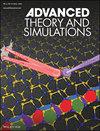Study of Optical and Thermoplasmonic Properties of Silica‐Core/Gold‐Shell Nanoparticles Integrated within Cell Organelles: A Finite Element Method
IF 2.9
4区 工程技术
Q1 MULTIDISCIPLINARY SCIENCES
引用次数: 0
Abstract
Photothermal therapy (PTT) using gold nanoparticles (GNPs) represent a promising innovation in biomedical treatment. Due to their unique optical properties, particularly surface plasmon resonance (SPR), gold nanoparticles can be activated by light to selectively destroy harmful cells, such as cancer cells, through heat generation. To enhance thermoplasmonic performance, gold nanoparticles can be combined with dielectric materials like silica (SiO₂) to form core/shell nanoparticles (). These structures show superior light‐to‐heat conversion compared to pure Au nanospheres, offering less invasive and more efficient cancer therapies. In this study, using the Finite Element Method (FEM), the optical and thermoplasmonic behavior of nanoparticles embedded in various subcellular locations—lysosome, membrane, mitochondria, nucleus, cytoplasm, and extracellular medium is investigated. It is analyzed how structural parameters like core radius and shell thickness affect surface plasmon resonance‐induced absorption and resulting heat generation. To evaluate their photothermal efficiency, the absorption efficiency, electric field enhancement, and local temperature rise are computed. These findings show that the optical and thermal responses of nanoparticles are strongly influenced by both nanoparticle structure and cellular localization. Notably, by tuning nanoparticles geometry and choosing appropriate target organelles, one can optimize laser parameters and thermal output, enabling highly effective and customizable photothermal therapy strategies for cancer treatment.集成在细胞器内的二氧化硅核/金壳纳米粒子的光学和热等离子体特性研究:一种有限元方法
使用金纳米颗粒(GNPs)的光热疗法(PTT)是生物医学治疗中一个有前途的创新。由于其独特的光学特性,特别是表面等离子体共振(SPR),金纳米颗粒可以被光激活,通过产生热量来选择性地破坏有害细胞,如癌细胞。为了提高热等离子体性能,金纳米颗粒可以与介电材料如二氧化硅(SiO₂)结合形成核/壳纳米颗粒()。与纯金纳米球相比,这些结构显示出优越的光热转换,提供更小的侵入性和更有效的癌症治疗。在这项研究中,使用有限元方法(FEM),研究了嵌入在不同亚细胞位置(溶酶体、膜、线粒体、细胞核、细胞质和细胞外介质)的纳米颗粒的光学和热等离子体行为。分析了核半径和壳层厚度等结构参数对表面等离子体共振诱导吸收和产生热量的影响。为了评价它们的光热效率,计算了吸收效率、电场增强和局部温升。这些发现表明纳米颗粒的光学和热响应受到纳米颗粒结构和细胞定位的强烈影响。值得注意的是,通过调整纳米颗粒的几何形状和选择合适的靶细胞器,可以优化激光参数和热输出,从而实现高效和可定制的癌症光热治疗策略。
本文章由计算机程序翻译,如有差异,请以英文原文为准。
求助全文
约1分钟内获得全文
求助全文
来源期刊

Advanced Theory and Simulations
Multidisciplinary-Multidisciplinary
CiteScore
5.50
自引率
3.00%
发文量
221
期刊介绍:
Advanced Theory and Simulations is an interdisciplinary, international, English-language journal that publishes high-quality scientific results focusing on the development and application of theoretical methods, modeling and simulation approaches in all natural science and medicine areas, including:
materials, chemistry, condensed matter physics
engineering, energy
life science, biology, medicine
atmospheric/environmental science, climate science
planetary science, astronomy, cosmology
method development, numerical methods, statistics
 求助内容:
求助内容: 应助结果提醒方式:
应助结果提醒方式:


